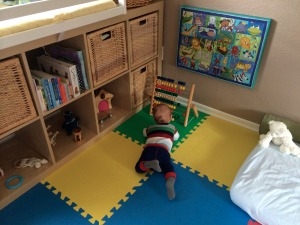
How to Develop Your Child’s Brain – 7 Months
29 Mar 2017 | 5 min Read
Kuhoo Gupta (The K Junction)
Author | 101 Articles
By 7 months, your bundle of joy will have started to sit upright without support. S/He might have even started crawling a little. If not then don’t worry, each child has their own blueprint of development.
The “absorbent mind” of infants is absorbing, through all their senses and we as parents need to provide them the necessary stimulus. Let us talk about how you can enrich the environment and experiences of your 7 months old baby. These activities are pointers/guidelines. Of course, they can be done before and after 7 months. So feel free to tweak them as per your child’s interest and understanding.
Floor Play The Montessori Way
You should give a lot of floor time to your baby at this age so s/he can make efforts to sit upright or try to make small movements. Just place a floor mat and you are good to go. To make it even more interesting and enriching, you can place a mirror where your child can see the reflection, observe himself and explore his own body and movements. It is also important to sit down and watch the space from the eye level of your child.
What do you see at that eye level? Is there anything interesting for the child or the toys are kept at a higher level where the child cannot even see what is present there? Maria Montessori emphasises that toys for the child should be kept in low shelves so that the child can actually see them and has easy access to them later when he becomes more mobile. Keeping the toys segregated in different trays is much better than dumping all of them in a large bin. An artwork or two at the eye level of the child would be great too!

Image Source: montessoribaby.wordpress.com
Familiar Faces Basket
Majority of us are a nuclear family setup and we do not meet our parents, in-laws and family very often. But that should not limit our babies from getting familiar with their family members. Around this age, I just printed faces of my family members (my son’s nana, nani, dadi, baba, chacha, chachi, mama, mami) on a normal A4 size paper. Its smart to laminate them for durability, so they survive abuses by the ever-mouthing infant. I then gave them to my child telling who is who. At that age, he used to enjoy those cards a lot and slowly he started recognizing who is who. It helps a lot in family bonding afterwards.

Music Instrument – Piano
It is never too early to introduce music and musical instruments to children. I gave my own piano (synthesizer) to my son to explore. You could buy a kids’ piano too, they are pretty cheap. He used to bang on it initially but slowly he started to understand that there is something more to it. A particular sound is played when he presses a particular key.
This exercise teaches kids about cause and effect and also exposes them to various sound frequencies. This is a brilliant way to stimulate their sense of hearing along with infusing love for music at this tender age. Sensorial exercises form an integral part of Montessori philosophy.

Mess Free Painting
Montessori education in general, has great ideas to help children develop an appreciation of art from the earliest age. So why not start now? Montessori principles encourage us to expose children to art from birth on itself! Dr. Montessori suggested parents and teachers to hang famous artists’ works at eye level for the child to facilitate appreciation of art. This particular mess free painting exercise not only helps in introducing art in a fun way but it also works on the sense of touch and vision.
A multisensory approach is ideal for babies. It also serves as a free play session, which is a very important and much neglected aspect of childhood these days. During free play, the child is in full control of the materials at hand and this helps in boosting the self esteem and confidence. To prepare this activity, take a paper and put blobs of paints (any paint would do since it is not going to touch the baby anyways). Put the paper inside a ziplock bag and give it to your child to explore. He will rub, crush and do whatever with that material but at the end; you would have a masterpiece created by your child.
 Image source: mummapapabubba.com
Image source: mummapapabubba.com
Flash Cards
Flash cards are large cards bearing pictures, words or numbers. They are ideal for infant stimulation. Glen Doman has his own research and resources about flash cards and there are many opinions floating around whether they are really helpful or not. For me, I used flash cards not with an expectation that my son will learn the information presented in the cards but I considered it as a tool to bond together and provide stimulation to his sense of vision.
Children have photographic memory and they tend to remember things as pictures, be it a picture or a word or anything. And when you repeatedly flash the cards in front of your child saying its name, s/he remembers it. This loosely forms the basis of flash cards.

I used the printable from mrprintables.com/printable-flash-cards.html
Do look out for more such easy-to-do, month-wise activities for children in this series.
A


Suggestions offered by doctors on BabyChakra are of advisory nature i.e., for educational and informational purposes only. Content posted on, created for, or compiled by BabyChakra is not intended or designed to replace your doctor's independent judgment about any symptom, condition, or the appropriateness or risks of a procedure or treatment for a given person.
